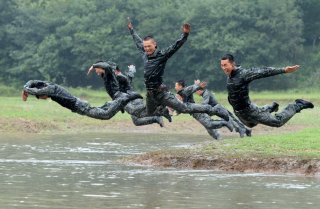Can China's People Liberation Army Fight in the Mountains?
Slinging load and airdrop in mountain areas is no easy task.
Here's What You Need To Remember: Does China have anything like the U.S. Chinook helicopter, which is able to airdrop mobile artillery or rocket launcher systems? Maybe not. That is a potential problem for a Chinese force that might have few options when it comes to deploying this kind of land firepower at mountainous altitudes greater than five thousand feet.
The Chinese military is firing off new rockets and artillery in its Western plateau region. This is the country’s latest effort to demonstrate high-altitude mobility and lethality near its border with India and other countries to the West.
The People’s Liberation Army (PLA) fired off its new PHL-11 self-propelled multiple rocket launcher, PCL-161 self-propelled howitzer, and PHL-03 long-range multiple rocket launcher, according to Chinese Communist Party mouthpiece The Global Times. The weapons conducted numerous live-fire exercises at high altitudes, the report said.
The emerging Chinese weapons all participated in wargaming exercises and simulations intended to refine the PLA’s ability to conduct precision-maneuver warfare at high altitudes in mountainous terrain. Interestingly, while China has also been acquiring ruggedized high-altitude combat vehicles for plateau transport and ground combat, the existence of these new weapons systems may face a deployment problem. Does China have anything like the U.S. Chinook helicopter, which is able to airdrop mobile artillery or rocket launcher systems? Maybe not. That is a potential problem for a Chinese force that might have few options when it comes to deploying this kind of land firepower at mountainous altitudes greater than five thousand feet.
China does have its Z-8 cargo transport helicopter, however, it is reported to operate with about one-half of the maximum take-off weight of the U.S. Army CH-47 Chinook. The Chinook can take off with as much as fifty thousand pounds, whereas public information specs on the Z-8 say its maximum take-off weight is twenty-eight thousand pounds. This differential may mean that the Chinese military may indeed be quite challenged to move its ground war forces and assets around mountain areas as its ability to sling load and airdrop appears much more limited than the U.S. Chinook. For example, a Chinook can carry an M777 mobile Howitzer or even several tactical wheeled vehicles up into mountainous areas to airdrop firepower. China operates its large Y-20 cargo aircraft however, as a fixed-wing asset, it is unlikely it would be able to hover sufficiently near active combat areas, land vertically, or airdrop essential weapons during conflict.
Certainly, on the surface, these kinds of Chinese weapons maneuvers could be aimed at deterring any potential rival from contemplating a land invasion of China, something which could be called extremely unlikely given the country’s terrain and the sheer size of its available military. Any attack on China is much more likely to be predominantly from the air, at least for quite some time until the possibility of land occupation becomes feasible.
However, the effectiveness of the new weapons and their live-fire exercises may ultimately be of little consequence, given that China may lack the means to successfully transport the assets at high altitudes and achieve the needed combat maneuver capacity.
Kris Osborn is the defense editor for the National Interest. Osborn previously served at the Pentagon as a Highly Qualified Expert with the Office of the Assistant Secretary of the Army—Acquisition, Logistics & Technology. Osborn has also worked as an anchor and on-air military specialist at national TV networks. He has appeared as a guest military expert on Fox News, MSNBC, The Military Channel, and The History Channel. He also has a Master's Degree in Comparative Literature from Columbia University.
This article is being reprinted due to reader interest.
Image: Reuters.

